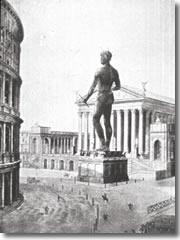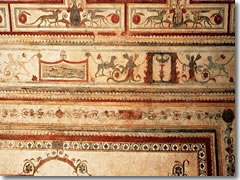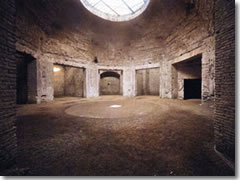Nero's fabulous and fabled Golden House finally reopened in 1999 after a 15-year restoration—then closed in 2005 to address structural problems, then reopened in 2007, then closed and opened again in 2008. It closed yet again in 2010 when part of the roof collapsed (see the box below for details).
Still, just in case it happens to be open when you are in town (and you aren't too concerned about falling bits of ancient masonry), you should definitely visit. It's amazing.
The Domus Aurea Reopens!
The sky really was falling. On March 30, 2010, workers were repairing part of the Golden House when suddenly a 100-square-meter (1,076-square-foot) section of the roof simply collapsed, thundering to the floor below and taking with it part of the gardens that are now planted above the palace.
The Domus Aurea has always suffered structural problems, and they have plagued it with repeated closures since it first reopened to the public at the turn of the 21st century. It closed to visitors for six years, but reopened—for weekend guided visits only—in late 2014.
The reason it is only open weekends: So workers can continue consolidating and resotring it during the week—work which will, eventually, open up even more rooms to the public. You can get updates on the progress of the restoration at archeoroma.beniculturali.it/cantieredomusaurea/In AD 64, Rome was swept by a disastrous fire—although, contrary to the gossips of the time, it has never been proved that Nero himself set the fire, much less played his lute while it burned.
(Lute? Yes, fiddles weren't invented yet, so that old phrase "he fiddled while Rome burned" is at least anachronistic—however, the deluded emperor did fancy himself quite the lutist.)
In fact, most reliable ancient historians, like Tacitus, say Nero wasn't even in Rome at the time of the fire, but rather was spending a spell in his hometown, the seaside city of Antium (World War II buffs will know it as Anzio).
When Nero returned to the fire-ravaged Rome, he set about an ambitious relief and rebuilding program—shelters for the homeless, food for the displaced masses, and new housing plans that were better able to withstand fire. He even paid for out of his own pocket. (That bit rarely makes it into the popular "Nero was a jerk" version of history.)

Since he was bankrolling the reconstruction effort, however, Nero saved the best of the newly-available (if slightly charred) real estate for himself. The emperor appropriated about three-fourths of the burned-out historic core—more than 200 acres—to create, in just four years, one of the most sumptuous palaces in history.
It sprawled from the Palatine Hill to the Esquiline Hill, with a private artificial lake created in between. Its rooms were slathered in frescoes and stuccoes, with entire rooms laminated in gold leaf (hence the nickname Domus Aurea, or "Golden House").
It was a party palace par excellence for an emperor who would go down in history as one of the most hated leaders of all time.
Subsequent emperors, seeking to distance themselves from their unpopular predecessor, destroyed much of the golden palace by using its vast network of rooms and walls as a foundation for new construction.
Trajan installed a baths complex over much of it in AD 98–117. Domitian built his own palace atop the Palatine section of the Golden House. Vespasian even filled in the palace's artificial lake to erect his huge Flavian Amphitheater for the people.

Before long, the fabulous Golden House had become merely underground foundations for the growing city of Rome.
Calling it a "party palace" is not just hyperbole. That's exactly what the Domus Aurea was. There were no bedrooms, no living quarters (Nero actually lived in another palace on the Quirinal Hill). Just rooms for lavish entertaining. Oddly, archaeologist have yet to find even the few functional rooms you'd think would be necessary even in a pleasure palace of banqueting halls (kitchens, bathrooms, etc.)
Of its original estimated 300 rooms, 30 have been opened to the public [though, again, these are currently closed], decorated with some of the sculptures, mosaics, and frescoes that have survived 2,000 years.

Sixteenth-century proto-archaeologists first rediscovered the Golden House—after construction crews in the area started digging up marvelous statues like the Vatican's Laocoön—by chopping through the roof and lowering themselves down on ropes.
Since the chambers they explored were—from their point of view—underground, they called them grottoes, and Renaissance painter Raphael, studying the fanciful and intricate frescoes of curlicues and ivy trails featuring fantastic creatures, christened the decorations grotteschi, which became anglicized as "grotesques."
The fact that these designs often featured leering masks, monsters, and other hideous creatures led the word in English to evolve eventually into an adjective describing anything horrible or disgusting.
The best bits on view are the Hall of Hector and Andromache, once illustrated with scenes from Homer's Iliad; the Hall of Achilles, with a gigantic shell decoration; and the Hall of the Gilded Vault, depicting satyrs raping nymphs, plus Cupid driving a chariot pulled by panthers.

This Aula Ottagona was also an engineering tour de force for the era—its vast empty space cleverly buttressed by piers within the walls and by adjoining rooms; the vault beginning as an octagon but ending as a perfect circle around the open oculus at its top—that influenced architecture right down to today.
When Nero moved in, he shouted, "At last I can start living like a human being!"
He didn't have long to enjoy it. Beset by rebel governors, deserted by the prefect of his own Praetorian Guard, and declared a public enemy by the Senate and sentenced to death by public beating, Nero fled to his countryside villa just outside of Rome where, spewing poetry and bemoaning his fate, he killed himself in June of AD 68.
Via della Domus Aurea 1, on the Esquiline Hill
tel. +39-06-3996-7700 for required reservations
www.isromantique.it
Sat–Sun 9:15am–3:45pm by guided tour only (booking required).
€16 (technically, €14 + €2 for the required reservation and tour)
Bus: 53, 85, 87, 117, 186, 571, 810, N11
Metro: Colosseo (B)
Hop-on/hop-off: Colosseo
Planning your day: The required tours (in English, Italian, and Spanish) last 75 minutes and depart every 15 minutes.
You must book a tour in advance.
Share this page
Search ReidsItaly.com
Via della Domus Aurea 1, on the Esquiline Hill
tel. +39-06-3996-7700 for required reservations
www.isromantique.it
Sat–Sun 9:15am–3:45pm by guided tour only (booking required).
€16 (technically, €14 + €2 for the required reservation and tour)
Bus: 53, 85, 87, 117, 186, 571, 810, N11
Metro: Colosseo (B)
Hop-on/hop-off: Colosseo